Black Squirrel
The black squirrel occurs as a "melanistic" subgroup of both the eastern gray squirrel and the fox squirrel. Their habitat extends throughout the Midwestern United States, in some areas of the Northeastern United States, eastern Canada, and also in the United Kingdom. The overall population of black squirrels is small when compared to that of the gray squirrel. The black fur color can occur naturally as a mutation in populations of gray squirrels, but it is rare. The rarity of the black squirrel has caused many people to admire them, and the black squirrels enjoy great affection in some places as mascots. As a rare mutation of both the eastern gray and fox squirrel, individual black squirrels can exist wherever gray or fox squirrels live. Among eastern squirrels, gray mating pairs cannot produce black offspring. Gray squirrels have two copies of a normal pigment gene and black squirrels have either one or two copies of a mutant pigment gene. If a black squirrel has two copies of the mutant gene it will be jet black. If it has one copy of a mutant gene and one normal gene it will be brown-black. In areas with high concentrations of black squirrels, litters of mixed-color individuals are common.
The black subgroup seems to have been predominant throughout North America prior to the arrival of Europeans in the 16th century, when America's old growth forests were still abundant and thick. The black squirrel's dark color helped them hide in these very dense and shaded old growth forests. As time passed, extensive deforestation and the hunting of squirrels for their meat and pelts led to biological advantages for gray colored individuals; their light-gray color became advantageous in their newly changed habitat. Today, the black subgroup is particularly abundant in the northern part of the eastern gray squirrel's range. This is due to two main factors. Firstly, black squirrels have a considerably higher cold tolerance than that of gray squirrels. Secondly, because the northern forests are denser and thus darker, the black squirrel enjoys the advantage of better concealment among this dimly lit habitat.
Large natural populations of black (eastern gray) squirrels can be found throughout Ontario and in several parts of Ohio, Maryland, Michigan, Houston, TX, Indiana, Virginia, Washington, D.C., Iowa, Wisconsin, Minnesota, and Pennsylvania.
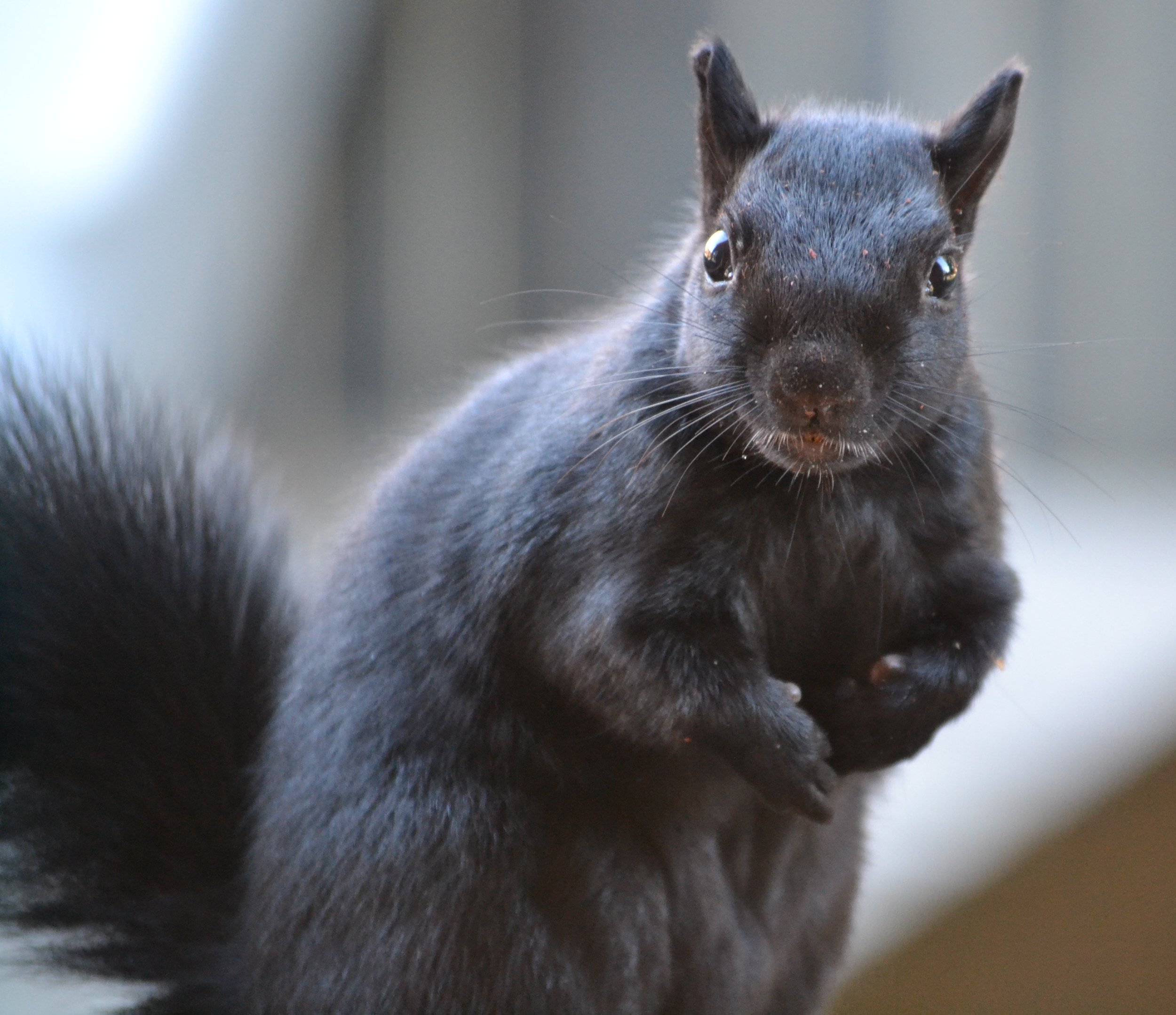
By DaPuglet. CC BY-SA 2.0, via Flickr
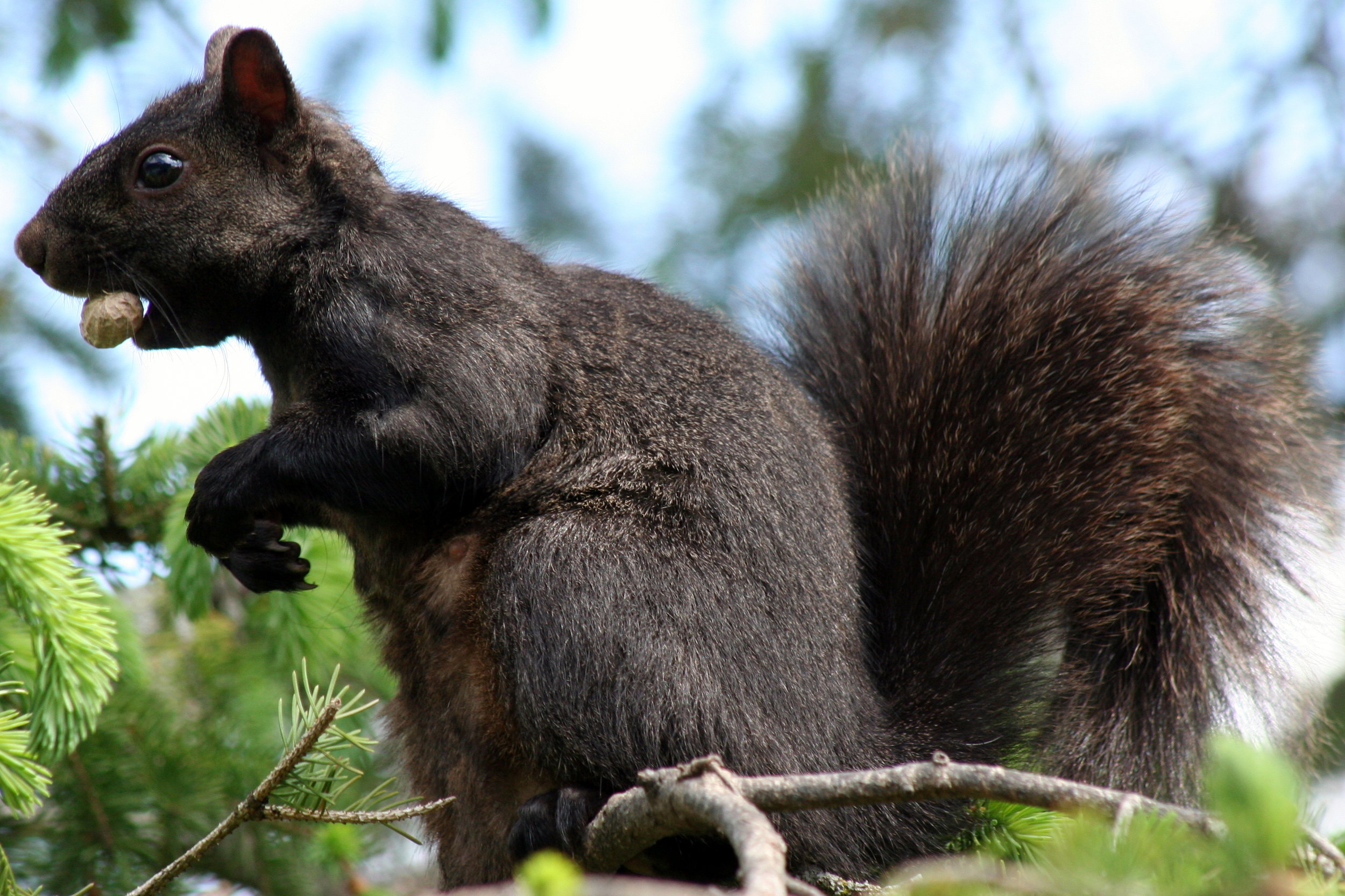
By Robert Taylor. CC BY 2.0, via Flickr
Cottontail Rabbit
Cottontail rabbits are among the 20 lagomorph species in the genus Sylvilagus, found in the Americas.
Most cottontail rabbits closely resemble the wild European rabbit (Oryctolagus cuniculus). Most Sylvilagus species have stub tails with white undersides that show when they retreat, giving them their name: "cottontails". This feature is not present in some cottontails (for example, the underside of the brush rabbit's tail is gray), nor is it unique to the genus (for example, the European rabbit also has a white scut).
The genus is widely distributed across North America, Central America, and northern and central South America, though most species are confined to particular regions. Most (though not all) species live in nests called forms, and all have altricial young.
Cottontail rabbits show a greater resistance to myxomatosis than European rabbits. The cottontail is one of several species of Sylvilagus; their closest relative is Brachylagus, the pygmy rabbit. They are more distantly related to the European and other rabbits, and more distantly still to the hares.
The lifespan of a cottontail averages about two years, depending on the location. Almost every living carnivorous creature larger or faster than the lagomorph is its predator. That includes: domestic dogs, humans, snakes, coyotes, mountain lions, foxes, and if the cottontail is showing signs of illness, even squirrels.
The cottontail's biggest threat comes from birds of prey. Newborn cottontails are particularly vulnerable to these attacks. Cottontail lagomorphs use burrows vacated by other animals. Predators such as snakes are well aware of the areas used and reused by the cottontails, and kill the young at will. The mother is unable to defend her young. Though cottontails are sexually active, and mated pairs have several offspring many times in all seasons, few survive to adulthood. Those that do, grow very quickly and are full grown adults at three months.
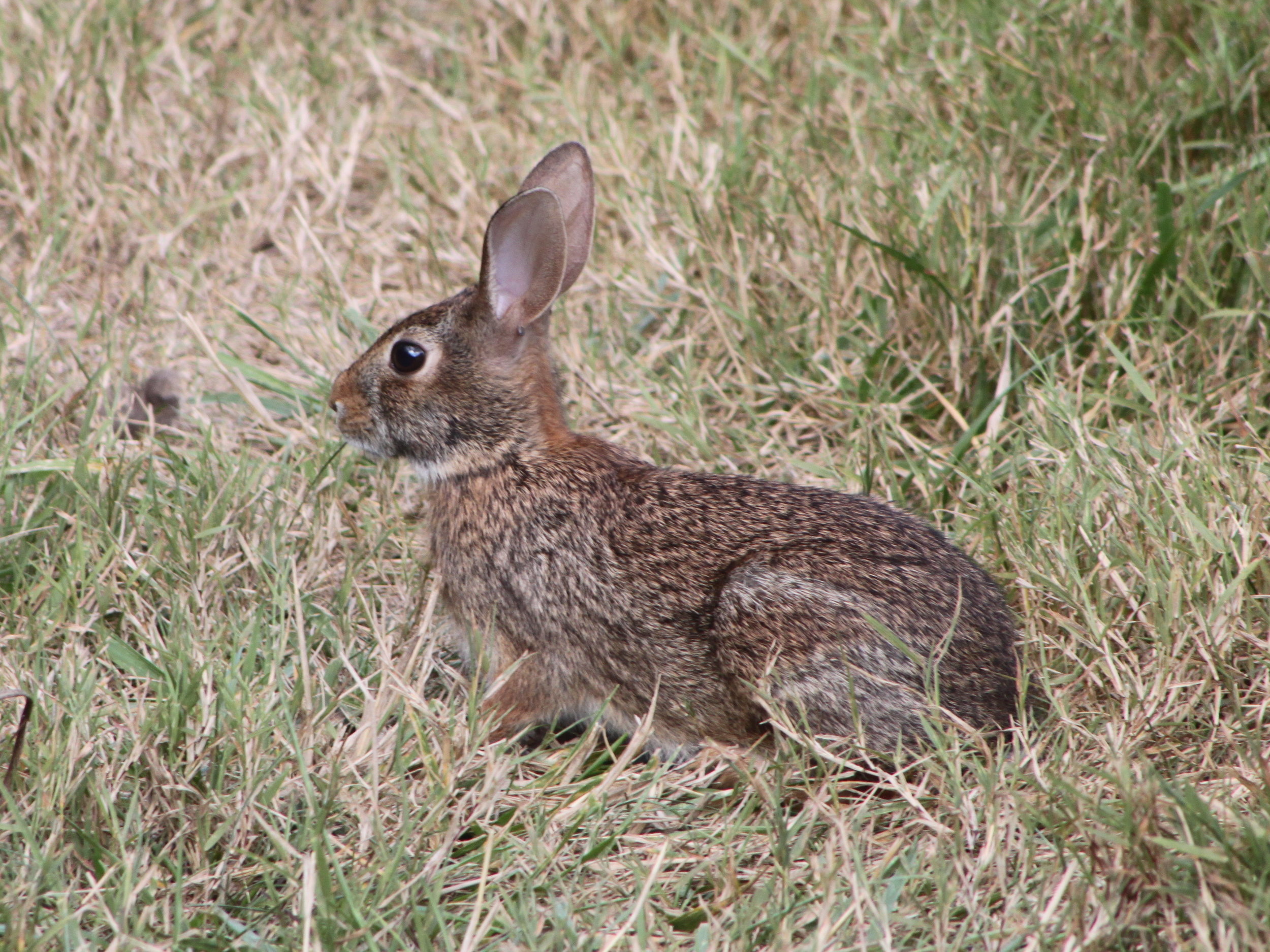
By Douglas Mills. CC BY-NC-ND 2.0, via Flickr
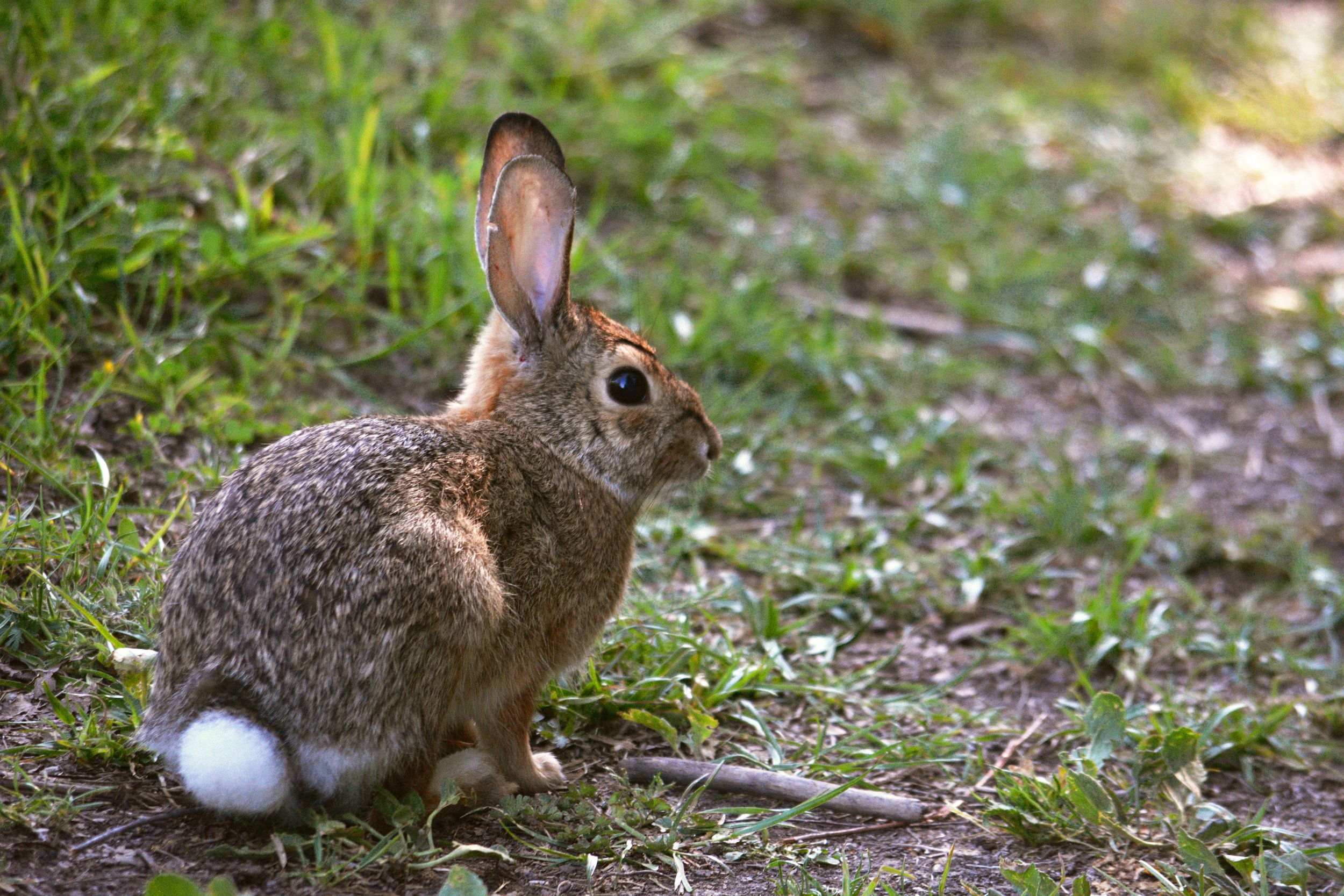
By Eric Sonstroem. CC BY 2.0, via Flickr
Coyote
The coyote Canis latrans, also known as the American jackal, is a canid native to North America. It is smaller than its close relative, the gray wolf, and slightly smaller than the closely related eastern wolf and red wolf. It fills much of the same ecological niche as the golden jackal does in Eurasia, though it is larger and more predatory.
The coyote is listed as least concern by the International Union for Conservation of Nature due to its wide distribution and abundance throughout North America, southwards through Mexico, and into Central America. The species is versatile, able to adapt to and expand into environments modified by humans. It is enlarging its range, with coyotes moving into urban areas in the Eastern U.S., and was sighted in eastern Panama (across the Panama Canal from their home range) for the first time in 2013.
The coyote is more closely related to the common ancestor of wolves and other canids (more "basal") than the gray wolf. As of 2005, 19 coyote subspecies are recognized. The average male weighs 18 to 44 lb and the average female 15 to 40 lb. Their fur color is predominantly light gray and red or fulvous interspersed with black and white, though it varies somewhat with geography. It is highly flexible in social organization, living either in a family unit or in loosely knit packs of unrelated individuals. It has a varied diet consisting primarily of animal meat, including deer, rabbits, hares, rodents, birds, reptiles, amphibians, fish, and invertebrates, though it may also eat fruits and vegetables on occasion. Its characteristic vocalization is a howl made by solitary individuals. Man is the coyote's greatest threat, followed by cougars and gray wolves. In spite of this, coyotes sometimes mate with gray, eastern, or red wolves, producing "coywolf" hybrids. In the northeastern United States and eastern Canada, the eastern coyote (a larger subspecies, though still smaller than wolves) is the result of various historical and recent matings with various types of wolves. Most recent studies show that most wolves contain some level of coyote DNA.
The coyote is a prominent character in Native American folklore, mainly in the Southwestern United States and Mexico, usually depicted as a trickster that alternately assumes the form of an actual coyote or a man. As with other trickster figures, the coyote uses deception and humor to rebel against social conventions. The animal was especially respected in Mesoamerican cosmology as a symbol of military might. After the European colonization of the Americas, it was reviled in Anglo-American culture as a cowardly and untrustworthy animal. Unlike wolves (gray, eastern, or red), which have undergone an improvement of their public image, attitudes towards the coyote remain largely negative.
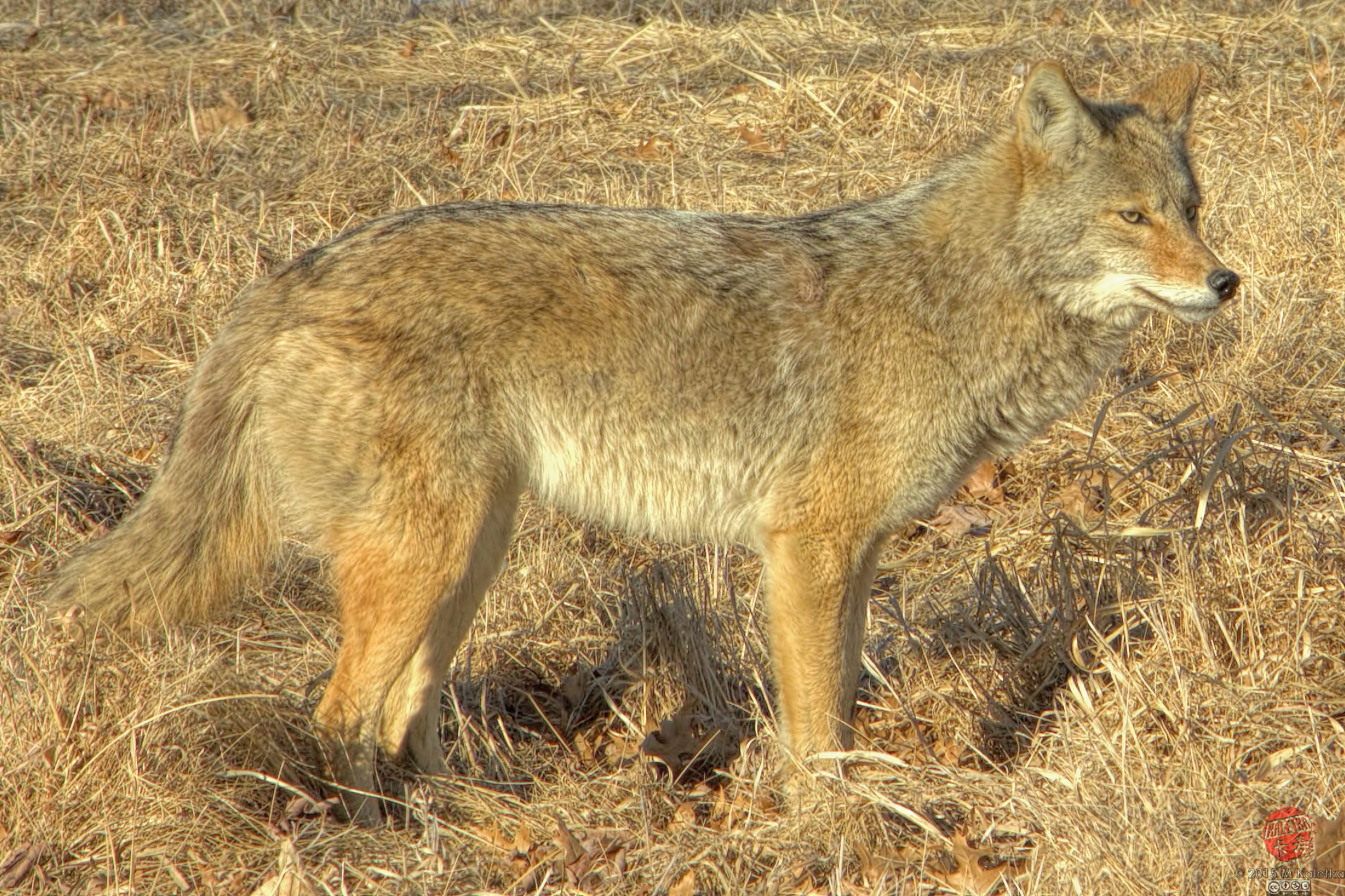
By Mark Kaletka. CC BY-NC-ND 2.0, via Flickr
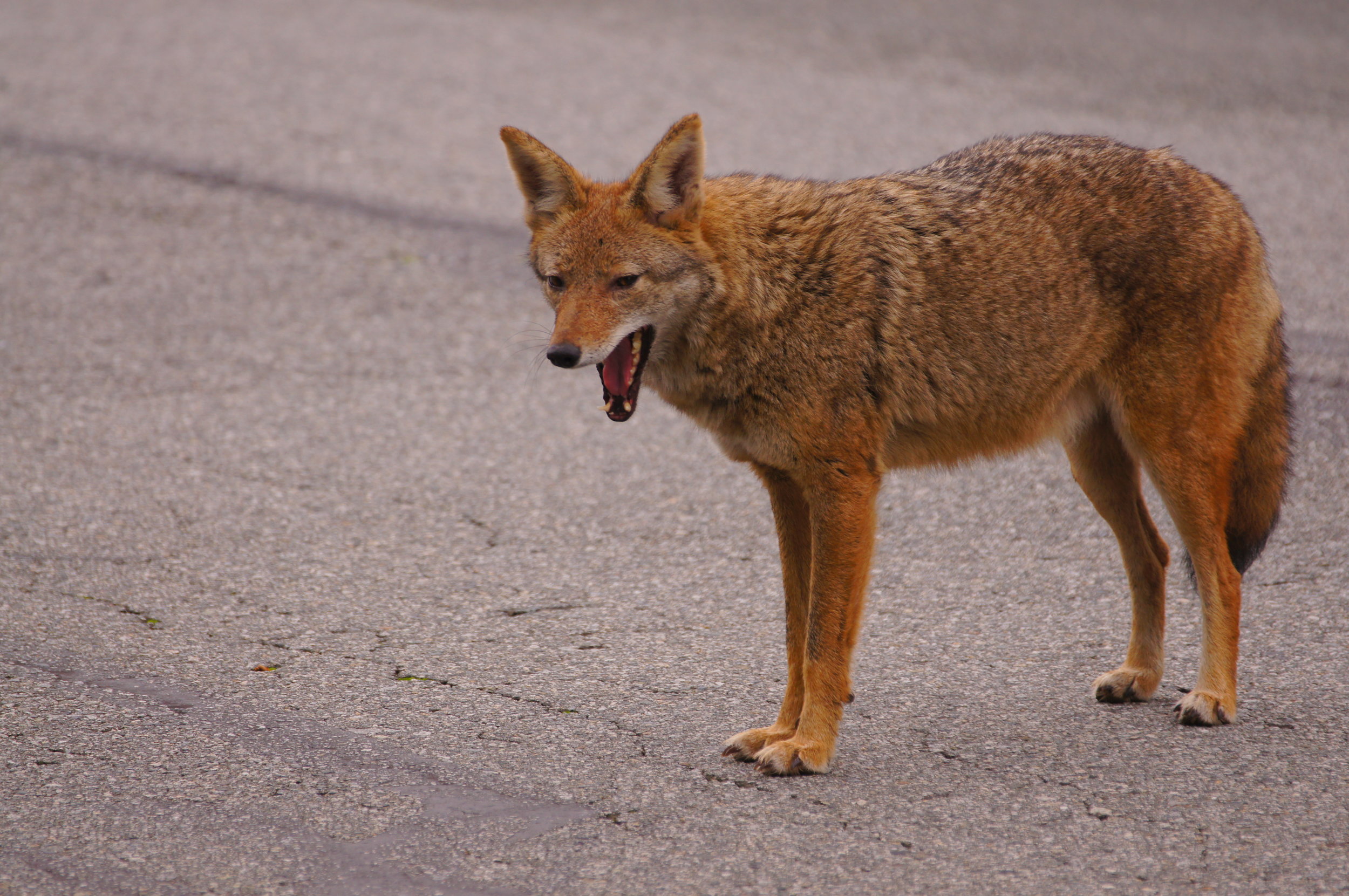
By Tjflex2. CC BY-NC-ND 2.0, via Flickr
Eastern Gray Squirrel
Sciurus carolinensis, common name eastern gray squirrel or grey squirrel depending on region, is a tree squirrel in the genus Sciurus. It is native to eastern North America, where it is the most prodigious and ecologically essential natural forest regenerator. The eastern grey squirrel in Europe is regarded as an invasive species.
Sciurus carolinensis is native to the eastern and midwestern United States, and to the southerly portions of the eastern provinces of Canada. The native range of the eastern gray squirrel overlaps with that of the fox squirrel (Sciurus niger), with which it is sometimes confused, although the core of the fox squirrel's range is slightly more to the west. The eastern gray squirrel is found from New Brunswick to Manitoba, south to East Texas and Florida. Breeding eastern gray squirrels are found in Nova Scotia, but whether this population was introduced or came from natural range expansion is not known. It has also been introduced into Ireland, Britain, Italy, South Africa, and Australia (where it was extirpated by 1973). Eastern grey squirrels in Europe are a concern because they have displaced some of the native squirrels there. This squirrel has also been introduced to Vancouver Island in Western Canada in 1966 in the area of Metchosin and has spread widely from there. The squirrels are considered highly invasive and a threat to both the local ecosystem and the native red squirrel.
A prolific and adaptable species, the eastern gray squirrel has been introduced to, and thrives in, several regions of the western United States. The gray squirrel is an invasive species in Britain; it has spread across the country and has largely displaced the native red squirrel, S. vulgaris. In Ireland, the red squirrel has been displaced in several eastern counties, though it still remains common in the south and west of the country. That such displacement might happen in Italy is of concern, and gray squirrels might spread from Italy to other parts of mainland Europe.
The eastern gray squirrel has predominantly gray fur, but it can have a brownish color. It has a usual white underside as compared to the typical brownish-orange underside of the fox squirrel. It has a large bushy tail. Particularly in urban situations where the risk of predation is reduced, both white – and black-colored individuals are quite often found. The melanistic form, which is almost entirely black, is predominant in certain populations and in certain geographic areas, such as in large parts of southeastern Canada. Genetic variations within these include individuals with black tails and black-colored squirrels with white tails.
The head and body length is from 9.1 to 11.8 in, the tail from 7.5 to 9.8 in, and the adult weight varies between 14 and 21 oz. They do not display sexual dimorphism, meaning there is no gender difference in size or coloration.
The tracks of an eastern gray squirrel are difficult to distinguish from the related fox squirrel and Abert's squirrel, though the latter's range is almost entirely different from the gray's. Like all squirrels, the eastern gray shows four toes on the front feet and five on the hind feet. The hind foot-pad is often not visible in the track. When bounding or moving at speed, the front foot tracks will be behind the hind foot tracks. The bounding stride can be two to three feet long.
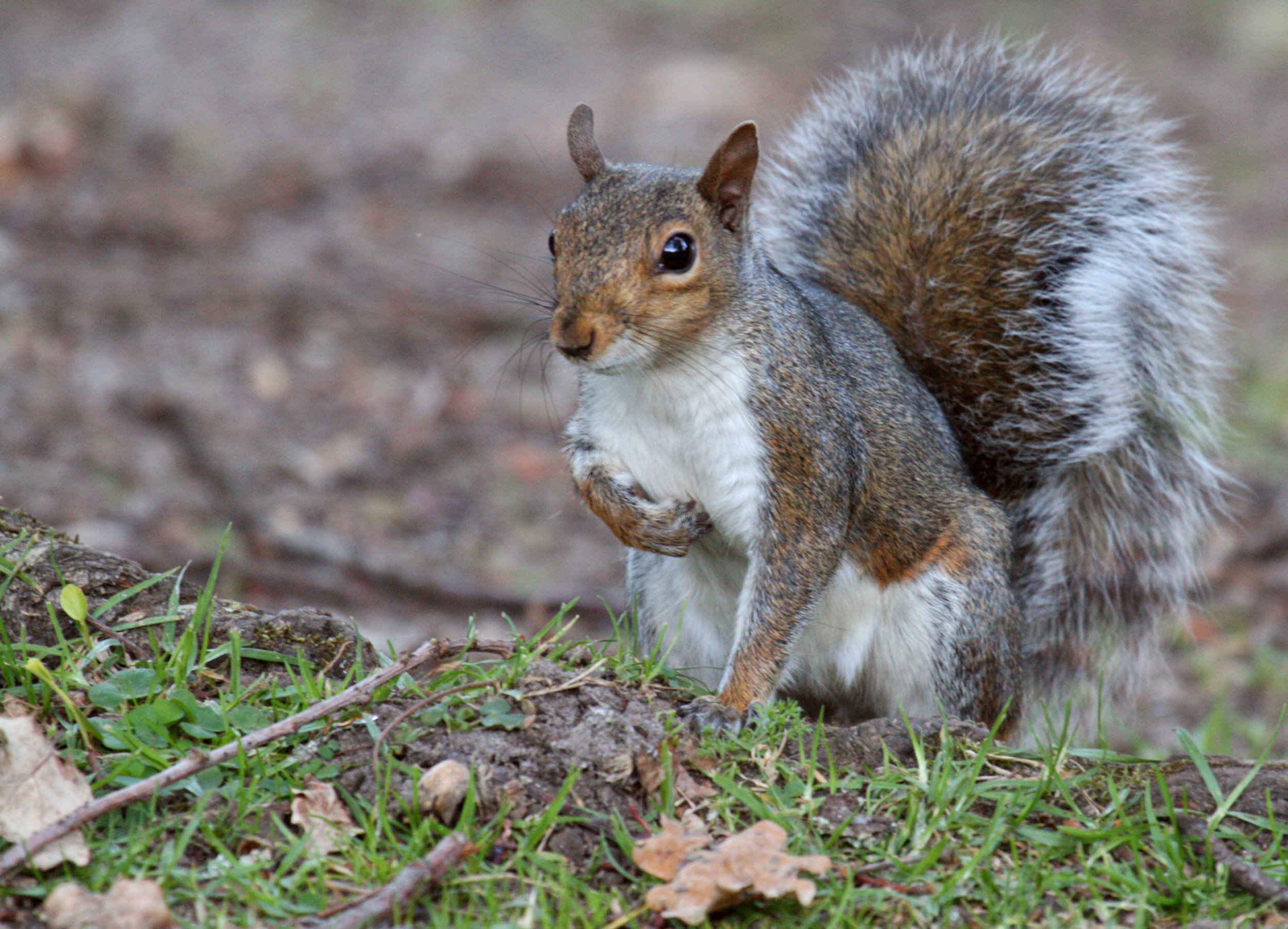
By Wildlife Wanderer. CC BY-NC-ND 2.0, via Flickr
Fox Squirrel
The fox squirrel (Sciurus niger), also known as the eastern fox squirrel or Bryant's fox squirrel, is the largest species of tree squirrel native to North America. Despite the differences in size and coloration, they are sometimes mistaken for American red squirrels or eastern gray squirrels in areas where the species co-exist.
The squirrel's total body length measures 17.7 to 27.6 in, tail length is 7.9 to 13.0 in, and they range in weight from 1.1 to 2.2 lb. There is no sexual dimorphism in size or appearance. Individuals tend to be smaller in the west. There are three distinct geographical phases in coloration: In most areas the animals upper body is brown-grey to brown-yellow with a typically brownish-orange underside, while in eastern regions such as the Appalachians there are more strikingly-patterned dark brown and black squirrels with white bands on the face and tail. In the south can be found isolated communities with uniform black coats. To help with climbing, they have sharp claws, developed extensors of digits and flexors of forearms, and abdominal musculature. Fox squirrels have excellent vision and well-developed senses of hearing and smell. They use scent marking to communicate with other fox squirrels. "Fox squirrels also have several sets of vibrissae, thick hairs or whiskers that are used as touch receptors to sense the environment. These are found above and below their eyes, on their chin and nose, and on each forearm."
The fox squirrel's natural range extends throughout the eastern United States, north into the southern prairie provinces of Canada, and west to the Dakotas, Colorado, and Texas. They are absent (except for vagrants) in New England, New Jersey, most of New York, as well as northern and eastern Pennsylvania. They have been introduced to both northern and southern California, Oregon, Idaho, Montana, Washington, and New Mexico. While very versatile in their habitat choices, fox squirrels are most often found in forest patches of 40 hectares or less with an open understory, or in urban neighborhoods with trees. They thrive best among oak, hickory, walnut, and pines, storing their nuts for winter. Western range extensions in Great Plains regions such as Kansas are associated with riverine corridors of cottonwood. A subspecies native to several eastern US states is the Delmarva fox squirrel (S. n. cinereus).
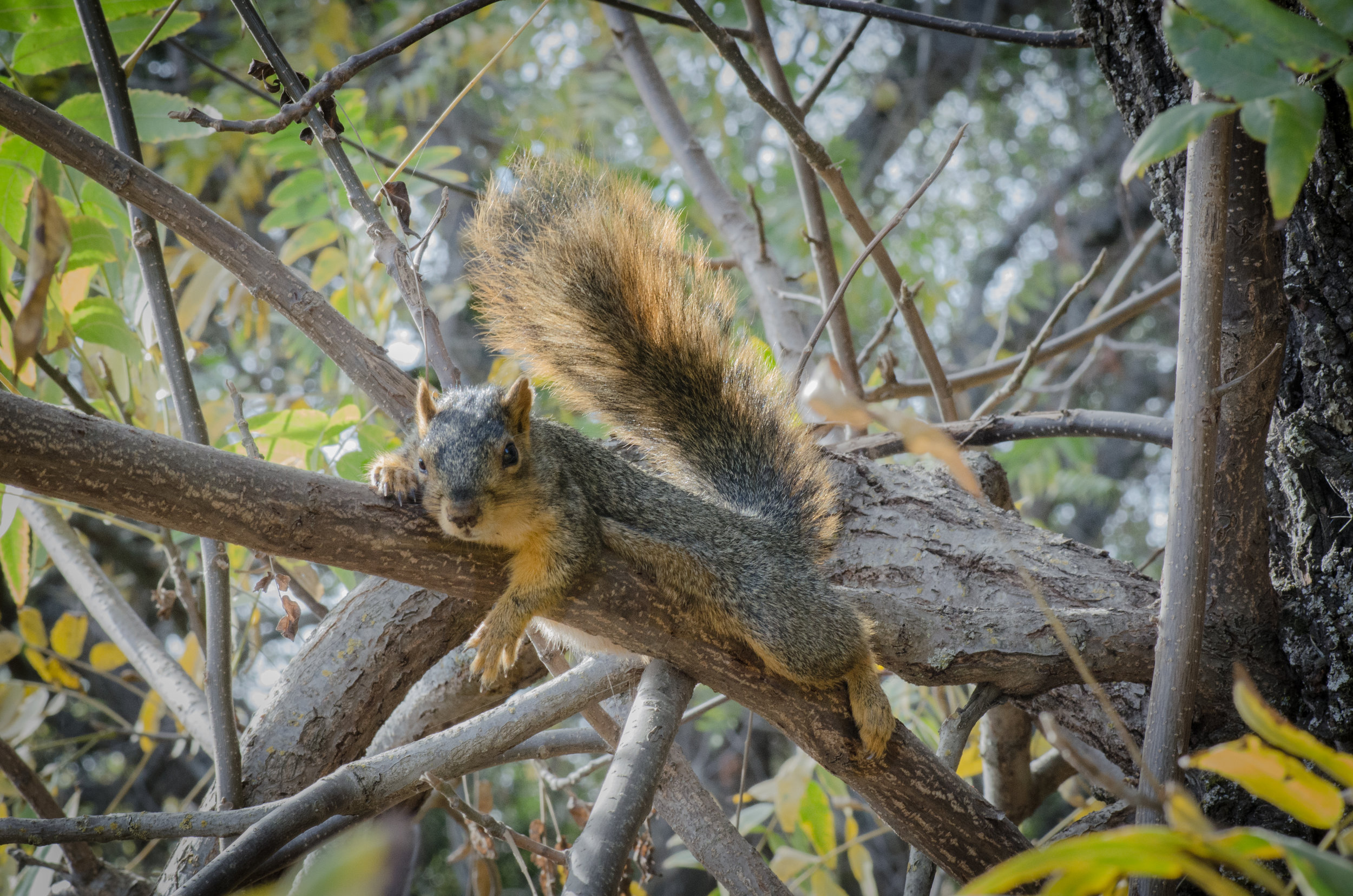
By Franco Folini. CC BY-SA 2.0, via Flickr
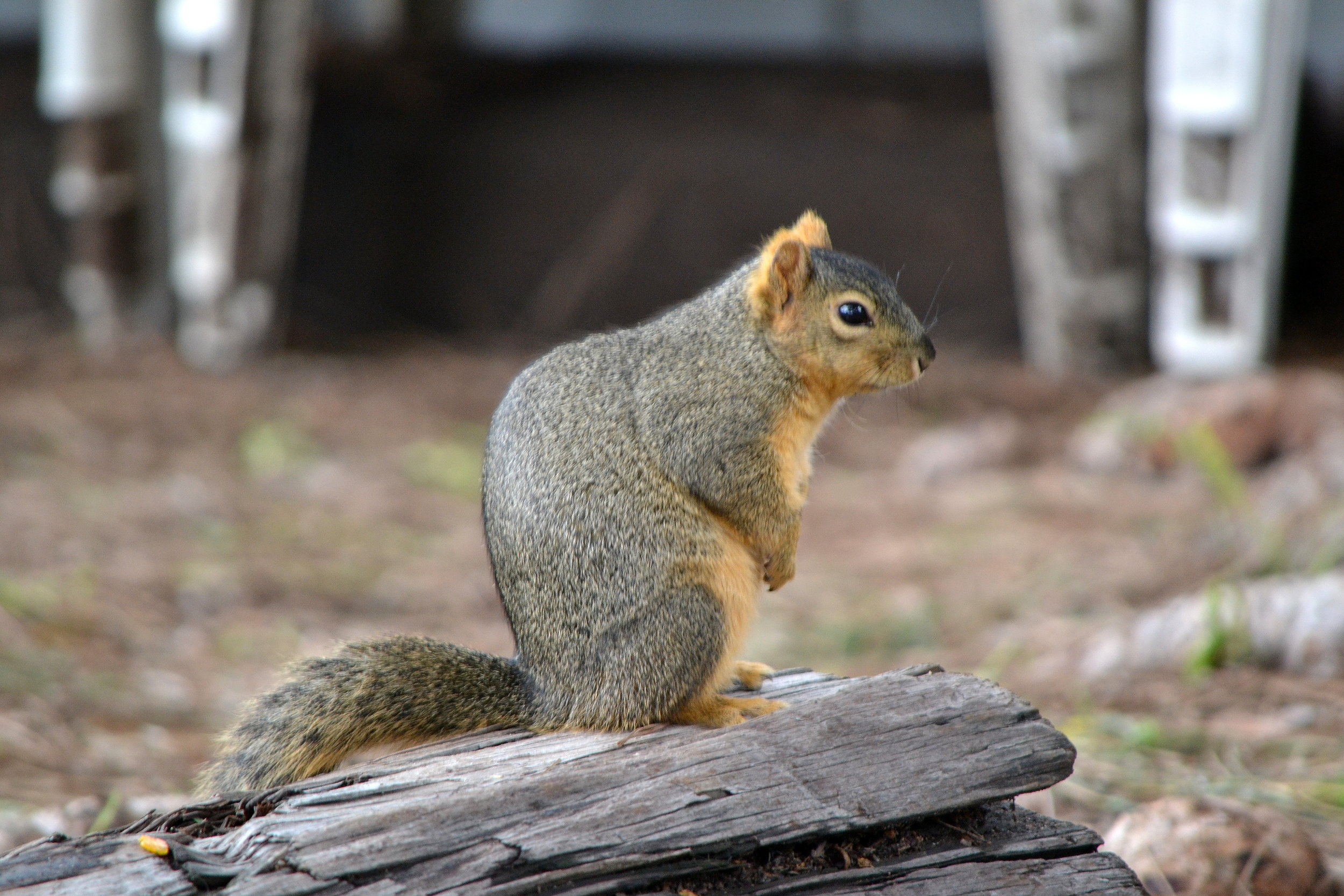
By Tracie Hall. CC BY-SA 2.0, via Flickr
North American River Otter
The North American river otter (Lontra canadensis), also known as the northern river otter or common otter, is a semiaquatic mammal endemic to the North American continent found in and along its waterways and coasts. An adult North American river otter can weigh between 5.0 and 14 kg (11.0 and 30.9 lb). The river otter is protected and insulated by a thick, water-repellent coat of fur.
North American river otters, like most predators, prey upon the most readily accessible species. Fish is a favored food among the otters, but they also consume various amphibians (such as salamanders and frogs), freshwater clams, mussels, snails, small turtles and crayfish. The most common fish consumed are perch, suckers, and catfish. Instances of North American river otters eating small mammals, such as mice and squirrels, and occasionally birds have been reported as well. There have also been some reports of river otters attacking and even drowning dogs.
The range of the North American river otter has been significantly reduced by habitat loss, beginning with the European colonization of North America. In some regions, though, their population is controlled to allow the trapping and harvesting of otters for their pelts. North American river otters are very susceptible to the effects of environmental pollution, which is a likely factor in the continued decline of their numbers. A number of reintroduction projects have been initiated to help halt the reduction in the overall population.

By Huntercoughlin, CC BY-SA 4.0, via Wikimedia Commons
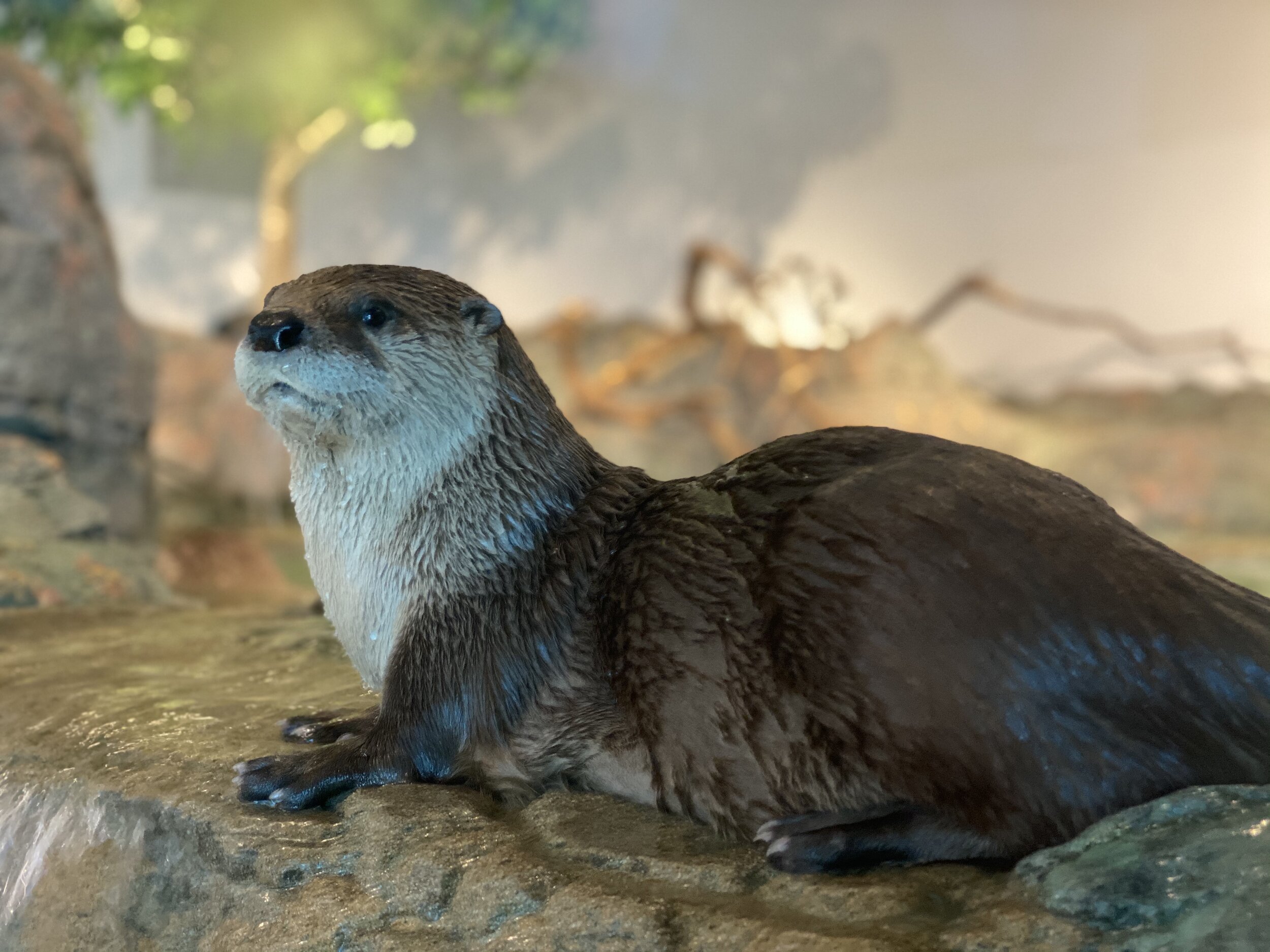
By Huntercoughlin, CC BY-SA 4.0, via Wikimedia Commons
Opposum
The opossum (Didelphis virginiana) is a marsupial of the order Didelphimorphia endemic to the Americas. The largest order of marsupials in the Western Hemisphere, it comprises 103 or more species in 19 genera. Opossums originated in South America, and entered North America in the Great American Interchange following the connection of the two continents. Their unspecialized biology, flexible diet, and reproductive habits make them successful colonizers and survivors in diverse locations and conditions.
The word "opossum" is borrowed from the Powhatan language and was first recorded between 1607 and 1611 by John Smith (as opassom) and William Strachey (as aposoum). Both men encountered the language at the British settlement of Jamestown, Virginia, which Smith helped to found and where Strachey later served as its first secretary. Strachey's notes describe the opossum as a "beast in bigness of a pig and in taste alike," while Smith recorded it "hath an head like a swine ... tail like a rat ... of the bigness of a cat." The Powhatan word ultimately derives from a Proto-Algonquian word meaning "white dog or dog-like beast."
The opossum is also commonly known as a possum, particularly in the Southern United States and Midwest. Following the arrival of Europeans in Australia, the term "possum" was borrowed to describe distantly related Australian marsupials of the suborder Phalangeriformes, which are more closely related to other Australian marsupials such as kangaroos.
"Didelphimorphia" refers to the fact that, like all marsupials, these animals have two("di") wombs("delphus").
Didelphimorphs are small to medium-sized marsupials that grow to the size of a house cat. They tend to be semi-arboreal omnivores, although there are many exceptions. Most members of this taxon have long snouts, a narrow braincase, and a prominent sagittal crest. By mammalian standards, these animals have an unusually full jaw of teeth. The incisors are very small, the canines large, and the molars are tricuspid.
Although all living opossums are essentially opportunistic omnivores, different species vary in the amount of meat and vegetation they include in their diet. Members of the Caluromyinae are essentially frugivorous; whereas the lutrine opossum and Patagonian opossum primarily feed on other animals. The yapok (Chironectes minimus) is particularly unusual, as it is the only living semi-aquatic marsupial, using its webbed hindlimbs to dive in search of freshwater mollusks and crayfish. The extinct Thylophorops, the largest known opossum at 4-7 kilos, was a macropredator. Most opossums are scansorial, well-adapted to life in the trees or on the ground, but members of the Caluromyinae and Glironiinae are primarily arboreal, whereas species of Metachirus, Monodelphis, and to a lesser degree Didelphis show adaptations for life on the ground.
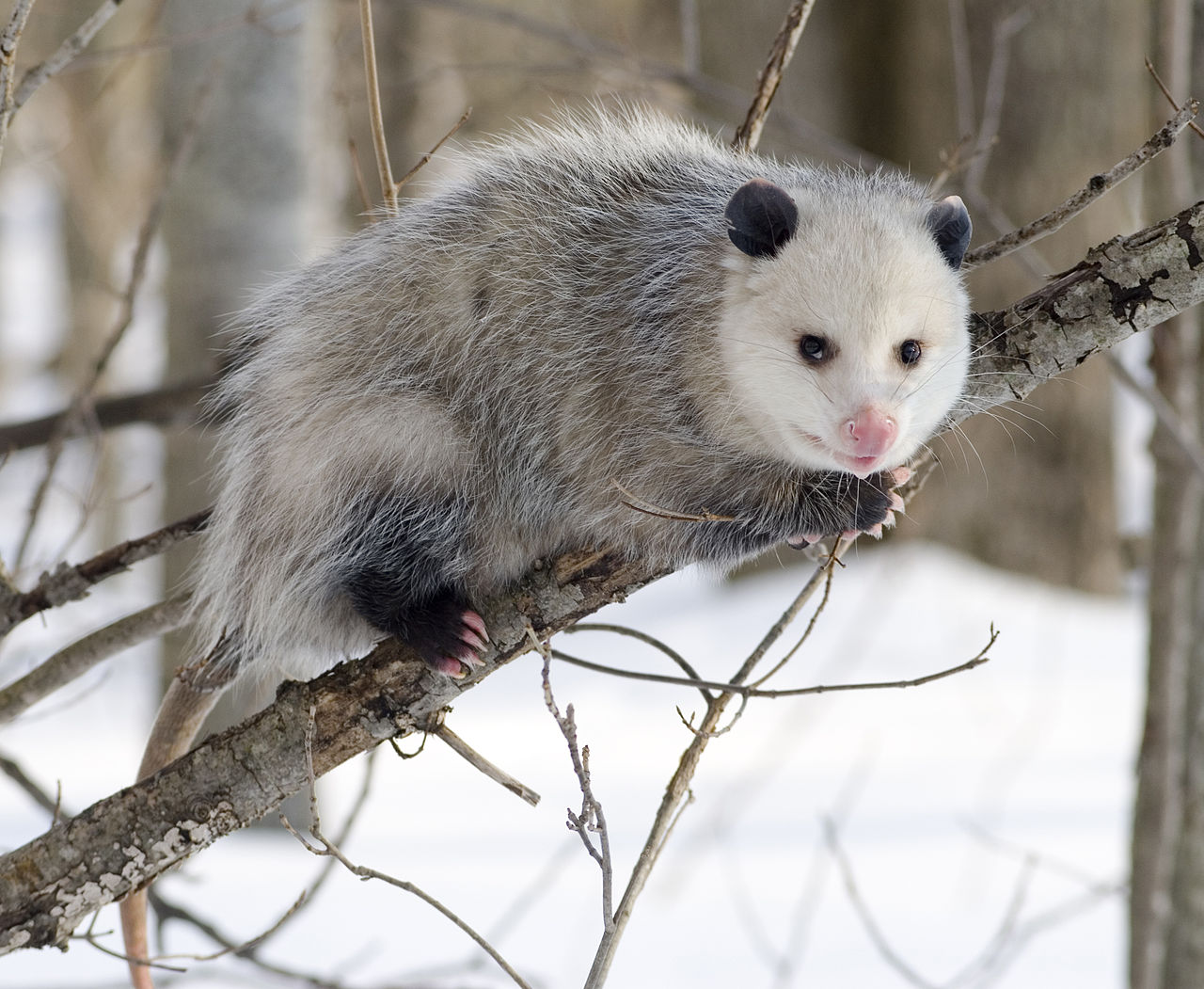
By Cody Pope (Wikipedia:User:Cody.pope). CC BY-SA 2.5, via Wikimedia Commons
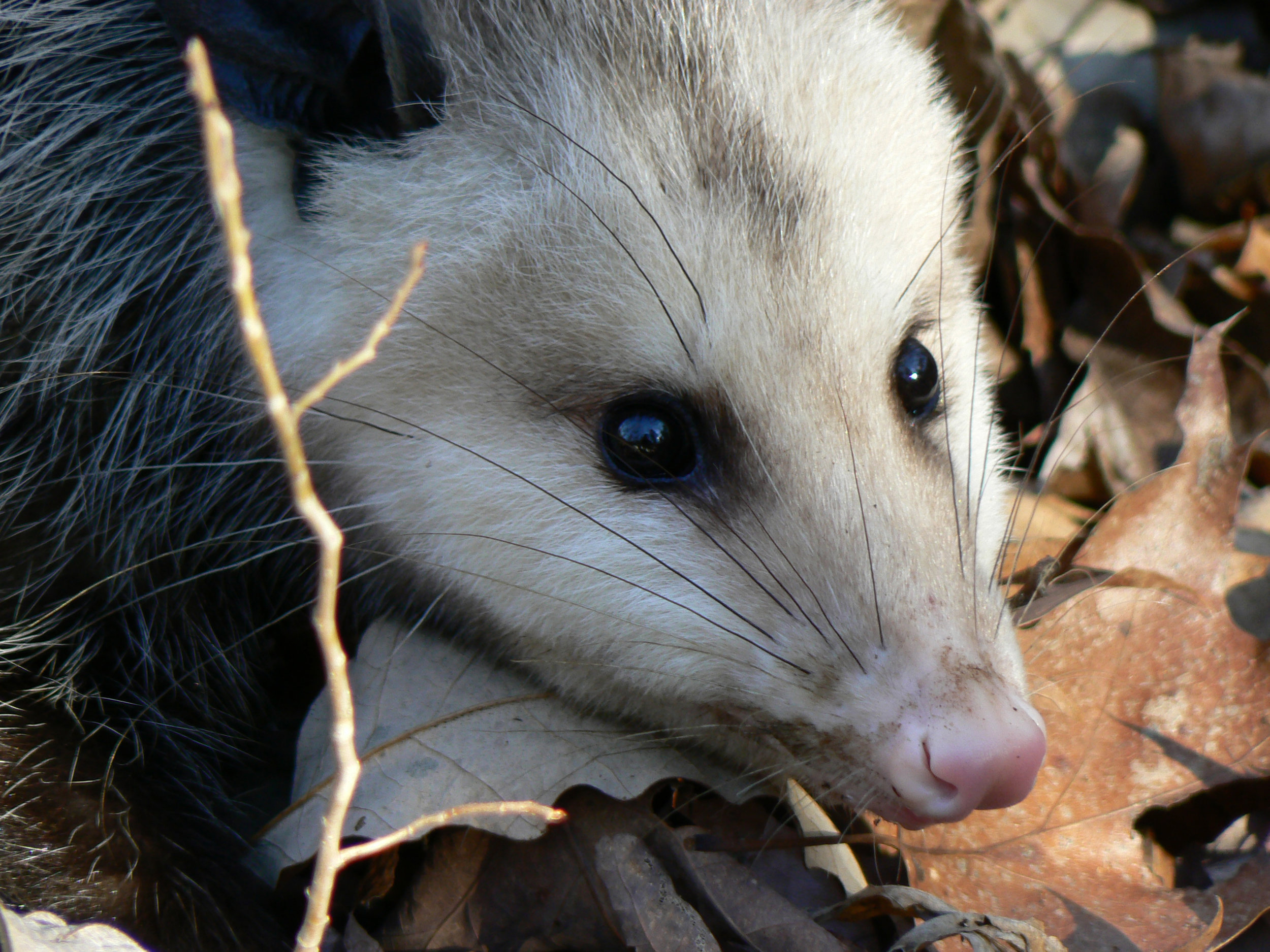
By Mark Bechemeyer. CC BY-NC 2.0, via Flickr
Raccoon
The raccoon (Procyon lotor), sometimes spelled racoon, also known as the common raccoon, North American raccoon, northern raccoon and colloquially as coon, is a medium-sized mammal native to North America. The raccoon is the largest of the procyonid family, having a body length of 16 to 28 in and a body weight of 8 to 20 lb. Its grayish coat mostly consists of dense underfur which insulates it against cold weather. Two of the raccoon's most distinctive features are its extremely dexterous front paws and its facial mask, which are themes in the mythologies of the indigenous peoples of the Americas. Raccoons are noted for their intelligence, with studies showing that they are able to remember the solution to tasks for up to three years.8 The diet of the omnivorous raccoon, which is usually nocturnal, consists of about 40% invertebrates, 33% plant foods, and 27% vertebrates.
The original habitats of the raccoon are deciduous and mixed forests, but due to their adaptability they have extended their range to mountainous areas, coastal marshes, and urban areas, where some homeowners consider them to be pests. As a result of escapes and deliberate introductions in the mid-20th century, raccoons are now also distributed across mainland Europe, Caucasia, and Japan.
Though previously thought to be solitary, there is now evidence that raccoons engage in gender-specific social behavior. Related females often share a common area, while unrelated males live together in groups of up to four animals to maintain their positions against foreign males during the mating season, and other potential invaders. Home range sizes vary anywhere from 3 hectares (7.4 acres) for females in cities to 12,000 acres for males in prairies. After a gestation period of about 65 days, two to five young, known as "kits", are born in spring. The kits are subsequently raised by their mother until dispersal in late fall. Although captive raccoons have been known to live over 20 years, their life expectancy in the wild is only 1.8 to 3.1 years. In many areas, hunting and vehicular injury are the two most common causes of death.

By David Menke. Public domain, via Wikimedia Commons
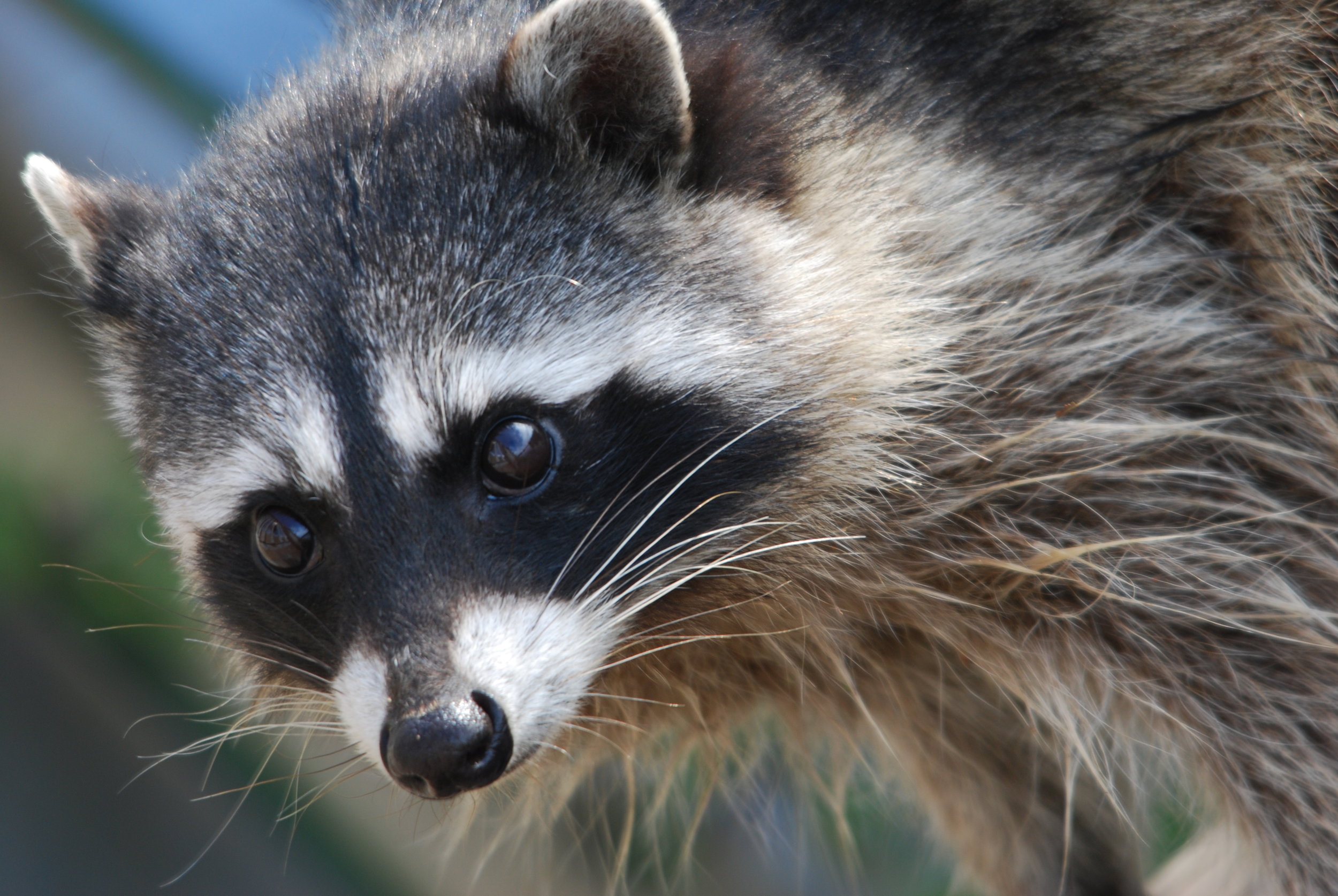
By David Slater. CC BY 2.0, via Flickr
Skunk
Skunks are mammals known for their ability to spray a liquid with a strong unpleasant smell. Different species of skunk vary in appearance from black-and-white to brown, cream or ginger colored, but all have warning coloration. Skunk species vary in size from about 15.6 to 37 in long and in weight from about 1.1 lb (spotted skunks) to 18 lb (hog-nosed skunks). They have moderately elongated bodies with relatively short, well-muscled legs and long front claws for digging.
Although the most common fur color is black and white, some skunks are brown or grey and a few are cream-colored. All skunks are striped, even from birth. They may have a single thick stripe across back and tail, two thinner stripes, or a series of white spots and broken stripes (in the case of the spotted skunk). Some also have stripes on their legs.
Skunks are omnivorous, eating both plant and animal material and changing their diets as the seasons change. They eat insects and larvae, earthworms, grubs, rodents, lizards, salamanders, frogs, snakes, birds, moles and eggs. They also commonly eat berries, roots, leaves, grasses, fungi and nuts.
In settled areas, skunks also seek garbage left by humans. Less often, skunks may be found acting as scavengers, eating bird and rodent carcasses left by cats or other animals. Pet owners, particularly those of cats, may experience a skunk finding its way into a garage or basement where pet food is kept. Skunks commonly dig holes in lawns in search of grubs and worms.
Skunks are one of the primary predators of the honeybee, relying on their thick fur to protect them from stings. The skunk scratches at the front of the beehive and eats the guard bees that come out to investigate. Mother skunks are known to teach this behavior to their young.
Skunks are notorious for their anal scent glands, which they can use as a defensive weapon. They are similar to, though much more developed than, the glands found in species of the family Mustelidae. Skunks have two glands; one on each side of the anus. These glands produce the skunk's spray, which is a mixture of sulfur-containing chemicals such as thiols (traditionally called mercaptans), which have an offensive and nauseating odour. A skunk's spray is powerful enough to ward off bears and other potential attackers. Muscles located next to the scent glands allow them to spray with a high degree of accuracy, as far as 10 ft. The smell aside, the spray can cause irritation and even temporary blindness, and is sufficiently powerful to be detected by a human nose up to 3.5 miles down wind.
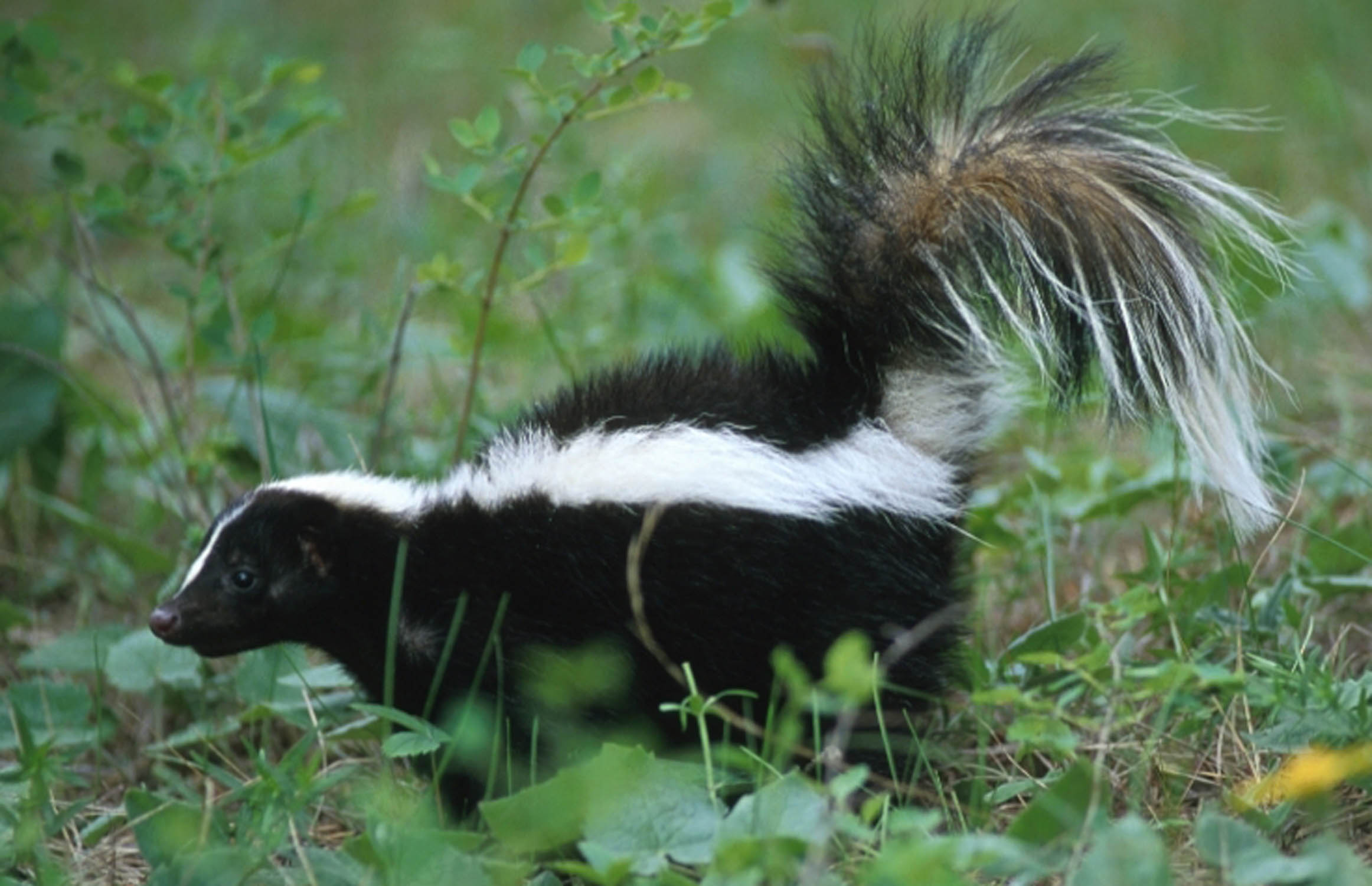
By Rikki's Refuge. CC BY 2.0, via Flickr



